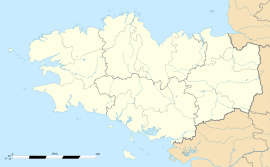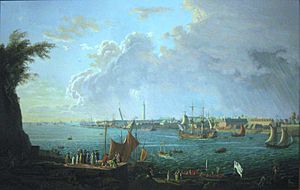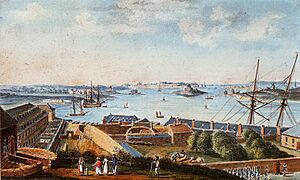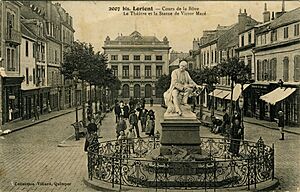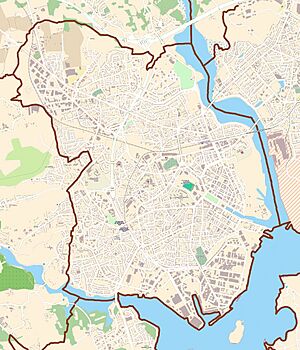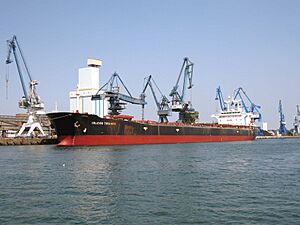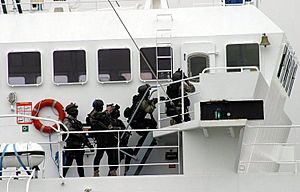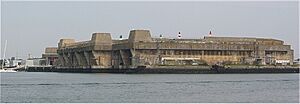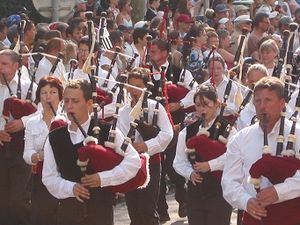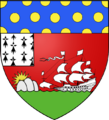Lorient facts for kids
Quick facts for kids
Lorient
An Oriant (Breton)
|
|||
|---|---|---|---|
|
Subprefecture and commune
|
|||
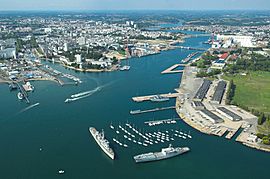
Aerial view of the harbour of Lorient
|
|||
|
|||
| Country | France | ||
| Region | Brittany | ||
| Department | Morbihan | ||
| Arrondissement | Lorient | ||
| Canton | Lorient-1 and 2 | ||
| Intercommunality | Lorient Agglomération | ||
| Area
1
|
17.48 km2 (6.75 sq mi) | ||
| Population
(2021)
|
57,846 | ||
| • Density | 3,309.3/km2 (8,571.0/sq mi) | ||
| Time zone | UTC+01:00 (CET) | ||
| • Summer (DST) | UTC+02:00 (CEST) | ||
| INSEE/Postal code |
56121 /56100
|
||
| Elevation | 0–46 m (0–151 ft) | ||
| 1 French Land Register data, which excludes lakes, ponds, glaciers > 1 km2 (0.386 sq mi or 247 acres) and river estuaries. | |||
Lorient (pronounced "Lor-yon") is a lively seaport city in Brittany, a region in western France. It's located where the Scorff and Blavet rivers meet the Atlantic Ocean. The city is famous for its history, especially its strong connection to the sea and its role during World War II. Lorient is also known for its big Celtic festival.
Contents
History of Lorient
Ancient Times
People have lived in the Lorient area for a very long time, since about 3000 BC. We know this because of ancient stone structures called megaliths. There are also ruins of Roman roads here, showing that the Gallo-Roman people were present.
How Lorient Started
In 1664, a man named Jean-Baptiste Colbert started the French East Indies Company. This company was created to trade with countries in the East. In 1666, King Louis XIV gave land to the company near a place called Port-Louis.
One of the company's directors, Denis Langlois, bought land where the Scorff and Blavet rivers meet. He built slipways there, which are ramps for building and launching ships. At first, this new place was just a small part of Port-Louis.
But in 1675, during a war, the company moved its main base from Le Havre to this new spot. They built a chapel, workshops, and offices. This new area was called l'Enclot, and it's where Lorient began to grow.
The city's name comes from the first ship built here in 1669, called Le Soleil d'Orient (The Sun of the East). Workers started calling the place "L'Orient," which later became "Lorient."
In 1690, the French Royal Navy opened a base in Lorient. The town grew, and by 1702, about 6,000 people lived there.
Growing with the Company of the Indies
Lorient really started to boom when John Law created the Perpetual Company of the Indies. This new company took over others and chose Lorient as its main base.
From 1720 to 1790, Lorient was involved in the Atlantic triangular slave trade. About 156 ships from Lorient transported an estimated 43,000 enslaved people.
In 1732, the Company moved its sales headquarters to Lorient. They built new stone buildings to handle all the business. Sales were huge, reaching up to 25 million livres tournois (an old French currency).
By 1738, Lorient had 14,000 people. If you included nearby villages, the population was 20,000. In 1735, new streets were built, and in 1738, Lorient officially became a city. They paved streets and built new docks. Old thatched houses were replaced with stone buildings.
In 1744, city walls were built, which helped when Lorient was attacked in 1746. When the Company closed in 1769, the city lost many people.
After the Company closed, Lorient became a big naval base for the French Navy. During the American Revolutionary War, many privateers (private ships allowed to attack enemy ships) sailed from Lorient. After the war, new trade routes opened to the United States.
The French Revolution and later wars stopped trade for almost 20 years.
19th and Early 20th Centuries

In the early 1800s, sea activities slowed down. Lorient became more of an administrative center. The city started to modernize in the mid-1800s. In 1825, new shipyards were built, and a sardine cannery opened. The first gasworks was built in 1845.
With the invention of the steam engine, ports became busier. The first locomotive (train) arrived in Lorient in 1865. The shipyards grew, building important ships like the Couronne (1861), which was made entirely of iron. In 1876, the Redoutable was built here, the first ship in the world with a steel structure.
Fishing also grew, especially after 1889. The Keroman fishing port started being built in 1920.
World War II and Reconstruction
In 1941, during World War II, the Germans built a large U-boat base in Lorient. These submarine facilities became targets for Allied bombing. The Germans built huge, bomb-proof shelters for their submarines. Karl Dönitz, the commander of the U-boat fleet, even moved his staff nearby.
From 1943 to 1944, Lorient was almost completely destroyed by Allied bombing. The goal was to destroy the submarine pens, but they were too strong. Instead, the city itself was heavily bombed to prevent Germans from getting workers and supplies. Before the bombings, thousands of leaflets were dropped, telling people to leave.
After the D-Day landings in 1944, Lorient was surrounded by Allied troops. The German soldiers in Lorient finally surrendered on May 10, 1945, two days after Germany's official surrender. In 1949, Lorient was honored with the Legion of Honour and the Croix de guerre for its bravery during the war.
After the war, Lorient needed to be rebuilt. Many temporary wooden shelters were built for people to live in. Some of these temporary homes lasted for decades. Today, only a few buildings from the 18th century remain.
Geography
Location
Lorient is on the south coast of Brittany. The rivers Scorff and Blavet meet here to form the roadstead of Lorient, which then flows into the Atlantic Ocean. The city is about 503 kilometers (313 miles) southwest of Paris.
Lorient has many different neighborhoods, including Keryado, Kerentrech, and Merville.
Adjacent towns:
 |
Quéven, Ploemeur |
Quéven, Caudan | Lanester |  |
| Ploemeur | Lanester | |||
| Ploemeur | Larmor-Plage, Port-Louis | Locmiquélic |
Climate
Lorient has an oceanic climate, meaning it has mild winters and cool to warm summers. It rains throughout the year. It rarely freezes in winter, and temperatures usually don't go above 30°C (86°F) in summer.
| Climate data for Lorient (Lann-Bihoué Airport) 1991–2020 normals, extremes 1952–present | |||||||||||||
|---|---|---|---|---|---|---|---|---|---|---|---|---|---|
| Month | Jan | Feb | Mar | Apr | May | Jun | Jul | Aug | Sep | Oct | Nov | Dec | Year |
| Record high °C (°F) | 16.8 (62.2) |
18.4 (65.1) |
23.3 (73.9) |
27.1 (80.8) |
29.8 (85.6) |
35.9 (96.6) |
37.6 (99.7) |
37.5 (99.5) |
31.0 (87.8) |
27.2 (81.0) |
19.6 (67.3) |
16.4 (61.5) |
37.6 (99.7) |
| Mean maximum °C (°F) | 13.5 (56.3) |
14.2 (57.6) |
17.5 (63.5) |
21.3 (70.3) |
25.3 (77.5) |
28.9 (84.0) |
29.7 (85.5) |
29.1 (84.4) |
26.5 (79.7) |
21.0 (69.8) |
17.0 (62.6) |
13.9 (57.0) |
31.4 (88.5) |
| Mean daily maximum °C (°F) | 9.7 (49.5) |
10.4 (50.7) |
12.6 (54.7) |
15.0 (59.0) |
18.1 (64.6) |
20.8 (69.4) |
22.5 (72.5) |
22.6 (72.7) |
20.7 (69.3) |
16.8 (62.2) |
13.0 (55.4) |
10.4 (50.7) |
16.1 (60.9) |
| Daily mean °C (°F) | 6.9 (44.4) |
7.1 (44.8) |
8.8 (47.8) |
10.7 (51.3) |
13.7 (56.7) |
16.4 (61.5) |
18.0 (64.4) |
18.1 (64.6) |
16.1 (61.0) |
13.3 (55.9) |
9.8 (49.6) |
7.5 (45.5) |
12.2 (54.0) |
| Mean daily minimum °C (°F) | 4.0 (39.2) |
3.8 (38.8) |
5.0 (41.0) |
6.4 (43.5) |
9.3 (48.7) |
11.9 (53.4) |
13.6 (56.5) |
13.5 (56.3) |
11.5 (52.7) |
9.7 (49.5) |
6.6 (43.9) |
4.6 (40.3) |
8.3 (47.0) |
| Mean minimum °C (°F) | −3.5 (25.7) |
−2.7 (27.1) |
−1.0 (30.2) |
0.4 (32.7) |
3.5 (38.3) |
6.3 (43.3) |
8.9 (48.0) |
8.0 (46.4) |
6.0 (42.8) |
2.8 (37.0) |
−0.1 (31.8) |
−2.6 (27.3) |
−4.9 (23.2) |
| Record low °C (°F) | −13.1 (8.4) |
−11.0 (12.2) |
−7.4 (18.7) |
−4.1 (24.6) |
−1.1 (30.0) |
1.6 (34.9) |
3.4 (38.1) |
4.1 (39.4) |
1.0 (33.8) |
−1.8 (28.8) |
−5.0 (23.0) |
−8.7 (16.3) |
−13.1 (8.4) |
| Average precipitation mm (inches) | 109.0 (4.29) |
82.5 (3.25) |
66.2 (2.61) |
67.5 (2.66) |
66.0 (2.60) |
52.0 (2.05) |
55.2 (2.17) |
53.3 (2.10) |
65.7 (2.59) |
103.8 (4.09) |
107.6 (4.24) |
114.5 (4.51) |
943.3 (37.16) |
| Average precipitation days (≥ 1 mm) | 14.3 | 11.6 | 10.9 | 10.6 | 9.8 | 8.0 | 8.3 | 7.7 | 8.3 | 12.6 | 13.8 | 14.2 | 130.1 |
| Average relative humidity (%) | 88 | 85 | 82 | 79 | 81 | 80 | 80 | 81 | 84 | 87 | 87 | 88 | 83.5 |
| Mean monthly sunshine hours | 70.6 | 98.6 | 143.7 | 190.8 | 214.1 | 224.3 | 231.7 | 219.4 | 192.8 | 119.9 | 87.1 | 72.0 | 1,865 |
| Source: Météo France, Infoclimat (humidity, 1961–1990), and Meteociel | |||||||||||||
Population
In 2017, Lorient had about 57,149 people living there. When you include the nearby towns that are part of its larger community, the total population was over 203,000. Lorient is the most populated town in the Morbihan area, even though Vannes is the main city. People from Lorient are called Lorientais.
The population numbers below show how many people lived in Lorient over the years. The town of Keryado became part of Lorient in 1947.
| Historical population | |||||||||||||||||||||||||||||||||||||||||||||||||||||||||||||||||||||||||||||||||||||||||||||||||||||||||||||||||||||||
|---|---|---|---|---|---|---|---|---|---|---|---|---|---|---|---|---|---|---|---|---|---|---|---|---|---|---|---|---|---|---|---|---|---|---|---|---|---|---|---|---|---|---|---|---|---|---|---|---|---|---|---|---|---|---|---|---|---|---|---|---|---|---|---|---|---|---|---|---|---|---|---|---|---|---|---|---|---|---|---|---|---|---|---|---|---|---|---|---|---|---|---|---|---|---|---|---|---|---|---|---|---|---|---|---|---|---|---|---|---|---|---|---|---|---|---|---|---|---|---|
|
|
|
|||||||||||||||||||||||||||||||||||||||||||||||||||||||||||||||||||||||||||||||||||||||||||||||||||||||||||||||||||||
| Source: EHESS and INSEE | |||||||||||||||||||||||||||||||||||||||||||||||||||||||||||||||||||||||||||||||||||||||||||||||||||||||||||||||||||||||
Breton Language
Lorient is working to promote the Breton language. In 2008, about 2.71% of children in primary schools attended classes taught in both French and Breton.
Economy
Lorient is known as "the city of five ports" because it has different types of ports:
- Fishing Port: The Keroman fishing port is one of the busiest in France. In 2010, it handled 27,000 tons of fish. It provides jobs for about 3,000 people, including 700 fishermen.
- Cargo Port: The Kergroise cargo port is the biggest in Brittany. It handles 2.6 million tons of goods each year, like oil, animal feed, and containers.
- Marinas: There are many places for boats to dock, including Lorient, Kernevel, and Port-Louis. There's also a special dock for offshore competitive sailing.
- Passenger Ships: Every year, over 457,500 people take ferries from Lorient to the nearby islands of Groix and Belle-Île-en-Mer.
- Military Port: While it's no longer a main French Navy base, new warships are still built at DCNS here.
Industry
Building ships has always been very important in Lorient. DCNS continues this tradition, building warships like frigates. There's also a large industrial area in Keroman that supports the fishing fleet.
Transport
Lorient South Brittany Airport is just west of the city. It has flights to Toulouse and used to have direct flights to Paris and Lyon.
The Gare de Lorient is the train station. You can take trains from here to Quimper, Nantes, Rennes, and Paris (in less than three hours by high-speed train).
Education
Schools in Lorient are part of the Academy of Rennes.
Higher Education
Lorient has several places for higher education:
- Université de Bretagne Sud (University of Southern Brittany).
- Institut universitaire de technologie de Lorient (University Institute of Technology).
- École nationale supérieure d'ingénieurs de Bretagne Sud (National Engineering School).
- École supérieure d'art (Art School).
- École nationale de musique et de danse (National School of Music and Dance).
Military
Important military units are based near Lorient:
- Naval Commandos: These are the special forces of the French Navy. They are highly trained, similar to the US Navy SEALs. Five of the six French naval commando units are based in Lanester, right across the Scorff river from Lorient. Their training school is also here.
- Naval Aviation Base: The Lann-Bihoué Naval Aviation Base is in Ploemeur. Squadrons based here do things like airborne early warning, maritime patrol, and air-sea rescue.
Lorient Submarine Base
Lorient was home to a huge submarine base built by the Germans during World War II. The head of the U-Boat Arm, Karl Dönitz, decided to build it in 1940. Between 1940 and 1942, massive concrete structures were built on the Keroman peninsula. These shelters could protect up to thirty submarines.
Even though Lorient was heavily bombed by the Allies, the submarine base survived the war. After the German surrender, the French Navy used the base. It was named after Jacques Stosskopf, a hero of the French Resistance. The base was closed in 1995 and is now used for civilian purposes.
Culture
Events
Every August since 1970, Lorient hosts the Festival Interceltique. This huge festival brings together artists and people from all over the Celtic world, including Brittany, Scotland, Ireland, Wales, and more. It's one of the biggest festivals in Europe, with hundreds of thousands of visitors.
Media
Lorient is home to TébéSud, a local TV channel that covers the Morbihan area.
Religion
Catholic churches are important landmarks in Lorient. The Church of Our Lady of the Assumption was built in 1850 in a Gothic style. The Saint Joan of Arc church was built in the 1930s. The modern church of Notre-Dame-de-Victoire has a tall concrete bell tower, making it the highest point in Lorient. Major Catholic holidays like Christmas and Easter are celebrated, along with local traditions like the Pardon ceremony.
Sports
Football
The most popular sports team in Lorient is FC Lorient, a football (soccer) club. They play in Ligue 1, which is France's top football league. Their nickname is les Merlus, which means "the hakes" (a type of fish). They play their home games at Stade du Moustoir.
Sailing
The old submarine base has been turned into a home for many famous sailors and their teams. Some well-known sailors based here include Franck Cammas, who won the 2011–12 Volvo Ocean Race, and Samantha Davies.
Lorient was also a stop for the 2011–12 Volvo Ocean Race and the starting point for la Solitaire du Figaro sailing race in 2009.
The famous sailor Eric Tabarly built three of his six Pen Duick boats in Lorient.
Notable People from Lorient
Many interesting people were born or lived in Lorient:
- Marie Dorval (1798–1849), a famous actress.
- Irène Frain (b. 1950), a well-known writer.
- Viktor Lazlo (b. 1960), a singer.
- Jean-Baptiste Bompard (1757–1842), a sailor who became an admiral.
- Yoann Gourcuff (b. 1986), a famous French football player.
- Pierre Fatou (1878–1929), a mathematician and astronomer.
- Nicole Le Douarin (b. 1930), a biologist.
- Jacques Stosskopf (1898–1944), a naval engineer and a hero of the French Resistance.
International Relations
Lorient is twinned with several cities around the world, meaning they have special friendly relationships:
 Galway, Ireland
Galway, Ireland Vigo, Spain
Vigo, Spain Wirral, England, United Kingdom
Wirral, England, United Kingdom Ventspils, Latvia
Ventspils, Latvia Ludwigshafen, Germany
Ludwigshafen, Germany České Budějovice, Czech Republic
České Budějovice, Czech Republic Denizli, Turkey
Denizli, Turkey
Images for kids
See also
 In Spanish: Lorient para niños
In Spanish: Lorient para niños





